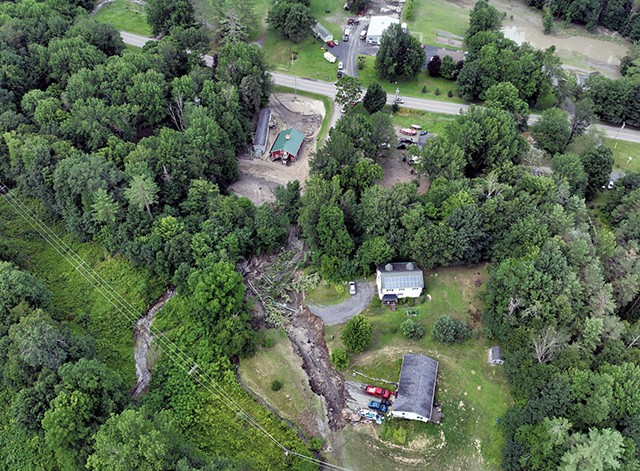
- Courtesy Of Ben Dejong
- Edge Drive from a drone
Kevin Sweeney stood outside his Moretown home on July 10 and watched the unnamed creek that typically trickles alongside his private road. As the remnants of Hurricane Beryl dumped record amounts of rain across central Vermont, the waterway exploded into a torrent. The muddy floodwaters raged down the center of Edge Drive, washing away the gravel road.
"That's when I went into the house and told my wife, 'We won't be leaving anytime soon,'" Sweeney recalled last week.
By morning, a massive, 15-foot-deep ravine had formed where Edge Drive had been. Sweeney and his wife, Virginia, as well as a family that lives farther up the road, were effectively cut off from the world. The only way the Sweeneys can now leave their home is to scamper down a muddy trail through the woods, leaving their stranded vehicles behind.
Nearly 9,000 miles of dirt roads crisscross Vermont, according to the Agency of Transportation, and many were washed out during the deluge. But while towns with damaged unpaved roads can expect some help from the state and federal government, people who live on private roads such as Edge Drive typically share the cost of maintaining them with neighbors. Some of those homeowners could now be on the hook for bills in the range of tens or even hundreds of thousands of dollars.
Difficult, costly flood recovery is becoming commonplace in Vermont. On Monday night into Tuesday morning, storms dumped up to eight inches of rain in the Northeast Kingdom, causing yet another series of flash floods that washed out roads, particularly around St. Johnsbury. Residents and public officials were assessing the extent of the latest damage even as homeowners such as the Sweeneys cope with the July 10 flooding.
Figuring out how to get Edge Drive repaired and how to pay for it has consumed the Sweeneys' lives since that flood, with no end or clear answers in sight.
"We don't know what to do," Sweeney said from the rim of the wide canyon outside the Cape-style home he purchased last year.
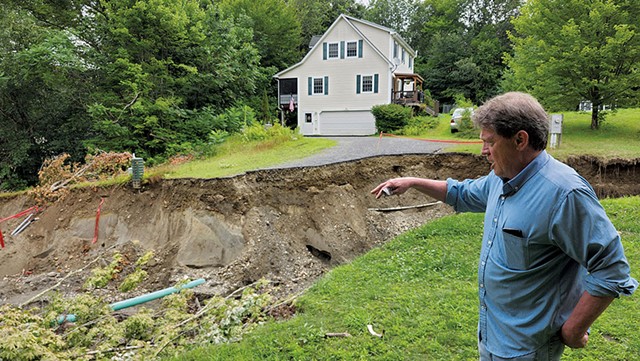
- Kevin Mccallum ©️ Seven Days
- Kevin Sweeney
In the immediate aftermath of the storm, state officials had a grasp of the impact on state infrastructure: 54 roads closed or damaged, eight bridges out, and significant damage to several railroad lines. Assessments of municipal and private roads, however, took time.
In Barnet, for example, the town-maintained Rake Factory Road was washed out, forcing the dozen or so residents to walk a mile to get into or out of their homes, said Bob Joly, who lives on the road and is director of the St. Johnsbury Athenaeum.
"The road was so demolished it was down to the bedrock," he said.
The intensity of the rainfall — as much as seven inches dumped in 12 hours — turned many small streams into destructive torrents, damaging roads not previously considered vulnerable.
"We are used to, by now, talking about inundation flooding," said Liz Schlegel Stevens, cochair of CReW — Community Resilience for the Waterbury Area — a nonprofit that manages flood recovery for Bolton, Duxbury, Moretown and Waterbury. "But it is flash flooding that does this kind of damage."
The full extent of the local destruction is still unclear. Many of the 2,200 homeowners reporting property damage so far have described washed out roads and driveways. Federal Emergency Management Agency officials are assessing these reports to determine whether and where to declare a federal disaster.
In counties that meet the threshold for individuals to get help from FEMA, private roads could qualify — under certain conditions. The homes would need to be owner-occupied and inaccessible due to the road damage.
Washington County, which is home to Moretown, is likely to qualify for a federal disaster declaration, but who would get money — and when — isn't clear.
At press conferences about the flooding, Gov. Phil Scott has said he worries that the destruction is worse than reported so far. He's encouraged Vermonters to continue to report storm damage to the state's 211 line.
"We're going to find that there's a lot of damage out there that we haven't seen yet on some of these back roads," Scott told reporters last week. An unknown number of homes are inaccessible, he said.
The damage to municipal roads in hard-hit Hinesburg is severe, estimated to cost at least $550,000 in repairs, according to town manager Todd Odit. Many private roads might have sustained destruction of comparable value, he said.
The state has asked the federal government to release emergency funds to speed the repair of state roads and has expedited the release of highway aid to help towns rebuild local roads faster, Vermont Transportation Secretary Joe Flynn told reporters.
It's clear from preliminary reports that damage to private roads in some areas is worse than after Tropical Storm Irene in 2011, Schlegel Stevens said.
"In Moretown alone, I can think of at least eight private roads with extensive damage," she said.
The scale of the damage stunned even those who have become battle-hardened by three floods in the space of a year. Waterbury Selectboard member Kane Sweeney — no relation to Kevin Sweeney — volunteered to deliver water-testing kits to Edge Drive homeowners whose wells might have been contaminated by the flooding.
Much of the hillside was washed away and deposited onto the valley below, and cars can't access two of the three homes. Last week, an SUV owned by a resident at the bottom of Edge Road remained buried in muck nearly to its windows.
"When I went out there and stood at the base of the driveway, I just said, 'Holy shit,'" Sweeney recalled. "The road doesn't exist anymore. It's a ravine."
Sweeney said it's heartbreaking to realize that homeowners on private roads will likely be on the hook for repairs many of them can't afford.
"Areas that have never been flooded before are beginning to flood, and it brings into question the integrity of our infrastructure," he said.
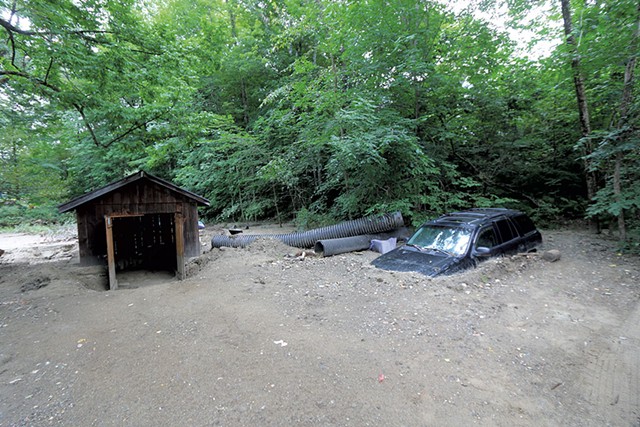
- Kevin Mccallum ©️ Seven Days
- Flood damage
The state has been working hard since Irene to rebuild roads and bridges in ways that help them better withstand flooding. After last year's deluge, officials noted that bridges rebuilt post-Irene without pilings in riverbeds held up well. But the Edge Drive washout underscores how private roads near smaller waterways remain vulnerable.
The issue can be even more complicated when multiple entities have overlapping rights-of-way and responsibilities for road maintenance.
In 2015, Vermont Electric Power Company, which manages the high-voltage power lines that serve as the backbone for the state's power grid, upgraded the transmission lines above Edge Drive. It built an access road over a creek and to the power lines. The utility installed a two-foot-diameter plastic culvert pipe so the creek could flow under the dirt road.
But neighbors say that culvert was too small and was plugged with debris from previous floods. It served as a barrier that diverted the floodwaters down Edge Drive, they contend.
VELCO spokesperson Shana Louiselle said the culvert "was appropriately sized at the time it was put in." The utility has a program to maintain its larger culverts around the state to prevent them from becoming clogged with debris — but not for smaller ones.
The utility sent a team to investigate the damage last week and is exploring what caused the blowout. The culvert may have played a role, Louiselle said, but if it did, it's just "one piece of the puzzle." Because multiple streams jumped their banks in the area, she doubts even a large culvert could have prevented the road damage.
"This is a really complex situation with multiple potential factors," Louiselle said.
State geologist Ben DeJong visited the site, which was first reported as a landslide, and said it is clear the culvert was too small to handle the volume of floodwaters. Even a culvert double the size might not have been big enough, he said.
But that doesn't mean anyone did anything wrong.
"We don't design for this kind of storm. We just don't," DeJong said, adding, "I don't know that anyone is building back better to that level, and that's the problem."
Kevin Sweeney, who works in marketing at a local arts organization, said he's hired a civil engineer to get an estimate for the work needed to repair Edge Drive, which will cost tens of thousands of dollars in materials alone. He said 95 percent of his life's savings are invested in his home, which the couple bought last year after moving from the Buffalo, N.Y., area.
They've had to borrow a car from a family member and leave it parked at the bottom of the hill. They're hauling groceries in by hand. And they won't be able to get heating oil delivered if the road isn't repaired by winter.
With FEMA yet to decide whether individuals in Washington County will qualify for disaster assistance and VELCO downplaying the role its culvert played in the damage, Sweeney worries he and his neighbors will be on their own.
"I'm 66," he said. "I don't want to have to have to work 'til I'm 85 to pay for this."



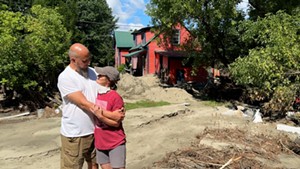
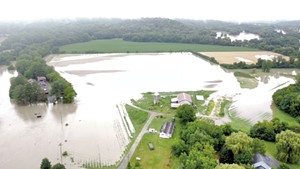










Comments
Comments are closed.
From 2014-2020, Seven Days allowed readers to comment on all stories posted on our website. While we've appreciated the suggestions and insights, right now Seven Days is prioritizing our core mission — producing high-quality, responsible local journalism — over moderating online debates between readers.
To criticize, correct or praise our reporting, please send us a letter to the editor or send us a tip. We’ll check it out and report the results.
Online comments may return when we have better tech tools for managing them. Thanks for reading.